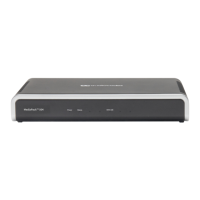Version 6.2 313 February 2011
SIP User's Manual 9. VoIP Networking Capabilities
To enable STUN, perform the following:
Enable the STUN feature (by setting the ini file parameter EnableSTUN to 1).
Define the STUN server address using one of the following methods:
• Define the IP address of the primary and the secondary (optional) STUN servers
(using the ini file parameters STUNServerPrimaryIP and
STUNServerSecondaryIP). If the primary STUN server isn’t available, the device
attempts to communicate with the secondary server.
• Define the domain name of the STUN server using the ini file parameter
StunServerDomainName. The STUN client retrieves all STUN servers with an
SRV query to resolve this domain name to an IP address and port, sort the server
list, and use the servers according to the sorted list.
Use the ini file parameter NATBindingDefaultTimeout to define the default NAT
binding lifetime in seconds. STUN is used to refresh the binding information after this
time expires.
Notes:
• STUN only applies to UDP (it doesn’t support TCP and TLS).
• STUN can’t be used when the device is located behind a symmetric NAT.
• Use either the STUN server IP address (STUNServerPrimaryIP) or
domain name (STUNServerDomainName) method, with priority to the
first one.
9.2.2 First Incoming Packet Mechanism
If the remote device resides behind a NAT device, it’s possible that the device can activate
the RTP/RTCP/T.38 streams to an invalid IP address / UDP port. To avoid such cases, the
device automatically compares the source address of the incoming RTP/RTCP/T.38
stream with the IP address and UDP port of the remote device. If the two are not identical,
the transmitter modifies the sending address to correspond with the address of the
incoming stream. The RTP, RTCP and T.38 can thus have independent destination IP
addresses and UDP ports.
You can disable the NAT mechanism by setting the ini file parameter DisableNAT to 1. The
two parameters EnableIpAddrTranslation and EnableUdpPortTranslation allow you to
specify the type of compare operation that occurs on the first incoming packet. To compare
only the IP address, set EnableIpAddrTranslation to 1, and EnableUdpPortTranslation to 0.
In this case, if the first incoming packet arrives with only a difference in the UDP port, the
sending addresses won’t change. If both the IP address and UDP port need to be
compared, then both parameters need to be set to 1.
9.2.3 No-Op Packets
The device's No-Op packet support can be used to verify Real-Time Transport Protocol
(RTP) and T.38 connectivity, and to keep NAT bindings and Firewall pinholes open. The
No-Op packets are available for sending in RTP and T.38 formats.
You can control the activation of No-Op packets by using the ini file parameter
NoOpEnable. If No-Op packet transmission is activated, you can control the time interval in
which No-Op packets are sent in the case of silence (i.e., no RTP or T.38 traffic). This is
performed using the ini file parameter NoOpInterval. For a description of the RTP No-Op ini
file parameters, see ''Networking Parameters'' on page 333.
RTP No
-Op: The RTP No-Op support complies with IETF Internet-Draft draft-wing-
avt-rtp-noop-03 ("A No-Op Payload Format for RTP"). This IETF document defines a

